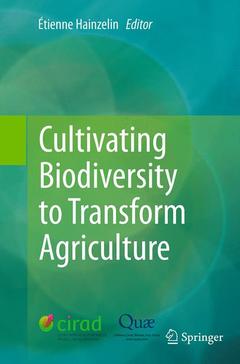Cultivating Biodiversity to Transform Agriculture, 2013
Coordonnateur : Hainzelin Étienne

Étienne Hainzelin, agronomist, has a doctorate in plant science. He has held several scientific positions in Côte d’Ivoire, Réunion, and several times in Brazil. Former Director of Research and Strategy at CIRAD, he is currently Adviser to the CEO of CIRAD. He is also a visiting professor at the University of Ottawa.
Date de parution : 08-2016
Ouvrage de 261 p.
15.5x23.5 cm
Disponible chez l'éditeur (délai d'approvisionnement : 15 jours).
Prix indicatif 105,49 €
Ajouter au panierDate de parution : 12-2013
Ouvrage de 261 p.
15.5x23.5 cm
Thèmes de Cultivating Biodiversity to Transform Agriculture :
Mots-clés :
Agriculture; Agronomy; Biodiversity; Food security; Innovation systems; Sustainable development
